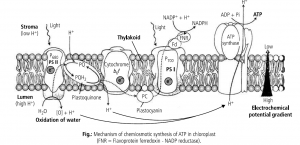Skip to contentChemiosmotic hypothesis of ATP formation
- In 1961, Peter Mitchell propounded this view in the case of chloroplast and mitochondria. He’s been awarded 1978 Nobel Prize in Chemistry for this discovery.
- The relation between the potential energy present within a concentration gradient of ions across a membrane and the use of this potential energy in the formation of ATP is explained by this hypothesis.
- According to this view, a proton gradient is produced by electron transport, both in respiration and photosynthesis.
- In the outer chamber or intermembrane space of mitochondria and inside the thylakoid lumen in chloroplasts, the gradient develops.
- Thylakoid lumen is enriched with H+ ion on the outside of the thylakoid membrane due to photolytic splitting of the primary electron acceptor of water. The electrons are transferred to an H-carrier. When transporting an electron to the carrier, the carrier removes a proton from the stroma membrane ‘s inner side.
- While the electron moves to the next carrier, the proton is released into the lumen.
- NaDP reductase is located on the outside of the membrane of the thylakoid.
- It obtains electrons from PS I and protons from the matrix to reduce the state of NaDP+ to NaDPH+ H+.
- The effect of the three events is that proton concentration decreases in the region of the matrix or stroma, while thylakoid lumen concentration increases, resulting in a decrease in pH.
- Across the thylakoid, a proton gradient develops.
- Due to proton movement through transmembrane channels, CF0 of ATPase (CF0-CF1 particle), the proton gradient is broken down.
- The rest of the membrane is H+ impermeable. CF0provides H+ or protons with facilitated diffusion.
- When protons move to the other side of ATP synthase, they cause conformative changes in the ATPase or coupling factor CF1 particle.
- ATP from ADP and inorganic phosphate form the transient CF1 particle of the ATPase enzyme.
- Therefore, chemiosmosis-based ATP synthesis requires a membrane, a proton pump, a proton gradient and CF0 – CF1 particle or ATPase.
- One molecule of ATP is formed when 3H+ pass through ATP synthase.


